Combined heat and power (CHP) systems have long been utilized in manufacturing and institutional settings to provide a reliable, energy-efficient—and thus more environmentally-friendly—source of power for a facility. That includes both new-build and retrofit applications. Now, a growing number of educational, commercial and even residential complexes are turning to cogeneration systems to meet their needs as electricity demand grows and they seek ways to lower energy costs.
Cogeneration (also referred to as Combined Heat and Power), can be best described as the “simultaneous production of two or more forms of energy from a single fuel source.” The primary function of a cogeneration plant is to create energy efficient power for nearby communities (larger plants or district energy systems) or auxiliary power for internal facility use (smaller plants). Wasted heat energy from the power generation process is then recaptured and used to generate steam, hot water, and/or chilled water (in tri-generation systems) to service other heating and cooling needs.
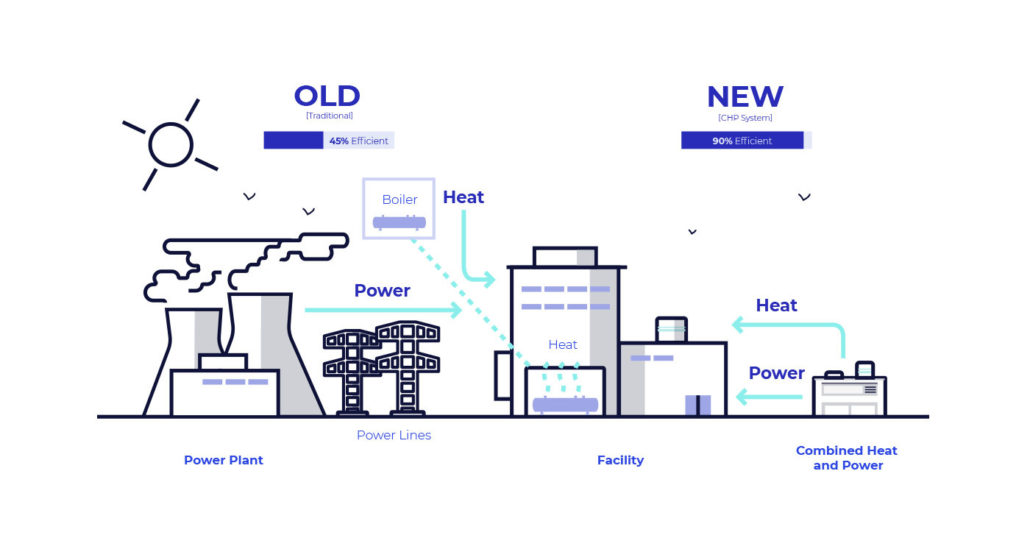 The International District Energy Association estimates that electricity produced by traditional power plants in the United States currently wastes more energy than the national energy use of 213 other countries. This video provides a good overview of the challenge:
The International District Energy Association estimates that electricity produced by traditional power plants in the United States currently wastes more energy than the national energy use of 213 other countries. This video provides a good overview of the challenge:
As IDEA notes, “By utilizing the thermal by-product of electric production, CHP plants regularly see fuel efficiencies of 70% – 85% or higher. This technology makes a district energy system an attractive energy solution for downtown areas, college campuses, or industrial entities that show a significant demand for thermal energy.”
Energy-efficiency with excess noise
But as with any power generation technology, CHP has its drawbacks—most notably, excessive sound emissions that create the need for active noise mitigation.
The challenge is that an increasing proportion of facilities that utilize CHP systems are in close proximity to residential areas and run afoul of local noise ordinances, while occupational health and safety legislation limits acceptable sound exposure ranges for employees within the buildings themselves. States and provinces across North America—Ontario and Massachusetts, to name two of the jurisdictions with the strictest noise control regulations—are intensifying noise enforcement and tightening their health and safety legislation to mandate lower sound emissions.
Most notably, community residents are no longer tolerating excessive noise pollution and are demanding action on the part of governments to curb unwanted sound.
CHP noise mitigation requires a proactive approach
Every CHP plant begins with a power generation source, most often a combustion engine. Depending on the size and operational design of the CHP plant, there will also be a series of other noise generating mechanical processes (e.g., heat exchangers, heat recovery steam generators, steam turbines, gas turbines, reciprocating engines, ventilation equipment, combustion exhaust, etc.) that are integral to the cogeneration process. As a result, cogeneration plants can easily generate sound levels in excess of 100 dB, well above the upper limits of regulatory noise ordinances. A well-designed noise mitigation strategy is therefore a general requirement of CHP plant designs to avoid the risk of costly fines, legal action or even the threat of facility closures.
Noise controls for CHP plants can often be significant in size and complexity, thus they could directly impact several critical facets of the system’s infrastructure (e.g., building structure, ventilation, aesthetics, etc.). As was discussed in our recent blog, ‘So you have a noise issue, now what?’, proactive noise control design is crucial to limiting both scheduling and cost risk to any combined heat and power project.
Common noise control for small to mid-sized CHP plants
The size and complexity of noise control for CHP plants is largely governed by three factors:
- Size of the plant itself (CHP plants can range from 200kW to hundreds of megawatts)
- Infrastructure available to install the noise generating equipment
- Proximity to residential communities (referred to as “receptors”)
CHP plants typically designed for individual facilities such as university buildings, hospitals, or manufacturing plants are generally limited to 25 megawatts of auxiliary power generation. These systems are often retrofit projects that require specific planning around where the cogeneration equipment will be installed (i.e., exterior on grade, exterior on a rooftop, or in an existing mechanical space inside the building). In any installation condition, the general elements requiring noise control are similar, and are generally centered around the power generating unit (i.e., the engine). Larger plants may also have additional turbines and heat recovery systems that would warrant similar noise control considerations. In the smaller to mid-sized CHP systems it is important to address four primary pathways for noise emissions:
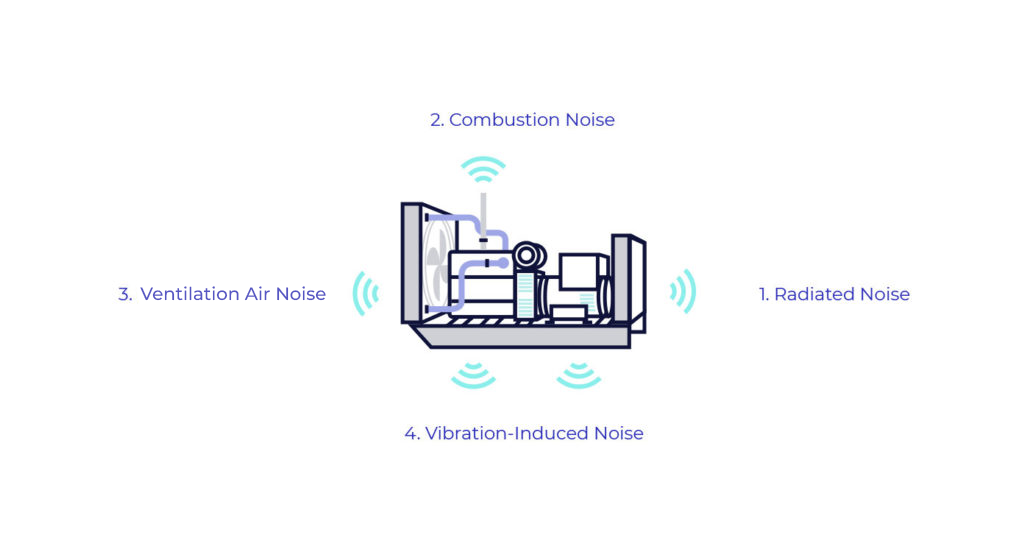
- Radiated Noise: Stemming from the engine itself, radiated noise is a general by-product of the combustion process. The enclosure and/or building envelope will need to be designed to provide for sufficient transmission loss at each octave band to limit breakout noise through to the exterior space. Specified levels of sound absorption must also be considered in the wall/roof panel design to reduce reverberant noise (and subsequently overall sound levels) within the mechanical space. Any other openings such as doors and access panels must also be designed to provide a complete acoustic seal during engine operation.
- Combustion Noise: Combustion noise stems directly from the engine’s combustion outlet. This would be commonly mitigated by a reactive combustion muffler. Another important consideration would be casing radiated noise off the muffler or SCR system that may create a secondary noise source. In these cases, additional shielding (e.g., an acoustic screen) or insulated lagging may be required.
- Ventilation Air Noise: Power generating engines are commonly cooled through an engine mounted radiator or auxiliary forced-air ventilation system. This system would move fresh ambient air across the engine(s) and exhaust it at an opposing outlet to keep the equipment cool during operation. Both the outside air and exhaust air openings would require sufficient silencing to attenuate noise generated from the ventilation air system as well as casing radiated noise that migrates through the ventilation path. The added external pressure drop on the cooling fans (imposed by the silencers) must also be considered to ensure cooling performance is not affected.
- Vibration Induced Noise: Vibratory transfer from the engine through the enclosure floor skid should be adequately attenuated using neoprene elements or steel spring isolators. Inadequate isolation can create unwanted structure-induced noise into the building structure (on rooftop applications), as well as vibratory excitation in the enclosure wall/roof panels. This vibratory excitation can in turn de-rate the acoustical properties of the enclosure envelope creating noise exceedances outside the enclosure.
Location of the CHP plant itself will dictate the complexity, size and type of noise control selected to address each of these four considerations. Three common scenarios are as follows:
- On-Grade Packaged Systems: These tend to be smaller CHP systems that would be installed in packaged enclosures with process piping and electrical connection, then fed into the building’s mechanical space.
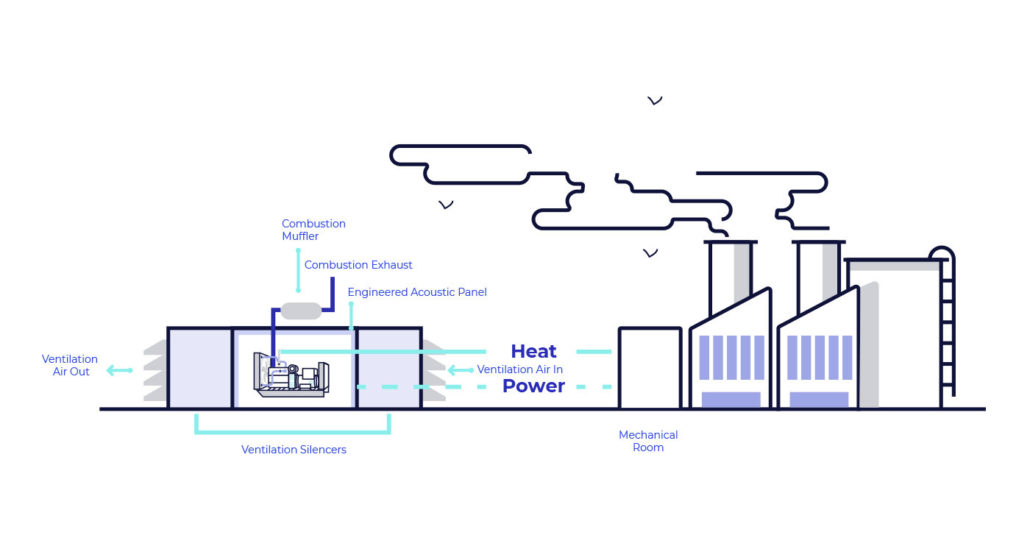 For these systems, most of the noise control considerations are focused on the engine’s enclosure. The enclosure casing and access doors must be adequately designed to attenuate the radiated noise off of the engine. The radiator system must be retrofit with intake and exhaust silencers capable of providing specified levels of dynamic insertion loss. A reactive muffler will need to be installed on the engine’s combustion exhaust. Finally, the engine will need to be mounted on top of vibration isolation to effectively decouple the generator from the enclosure structure.
For these systems, most of the noise control considerations are focused on the engine’s enclosure. The enclosure casing and access doors must be adequately designed to attenuate the radiated noise off of the engine. The radiator system must be retrofit with intake and exhaust silencers capable of providing specified levels of dynamic insertion loss. A reactive muffler will need to be installed on the engine’s combustion exhaust. Finally, the engine will need to be mounted on top of vibration isolation to effectively decouple the generator from the enclosure structure.
Failure to select proper components for each of these elements during the design stage may require the need to install retrofit noise controls once the plant is commissioned (see our case study for an example of this application).
- Free-standing building or building addition: When cogeneration plants reach a certain size (and there is space available) it may be more practical to construct a new space to house the equipment. From a noise control perspective, this allows the consolidation of controls in certain elements of the building design. This can be more desirable from both a cost and practicality perspective.
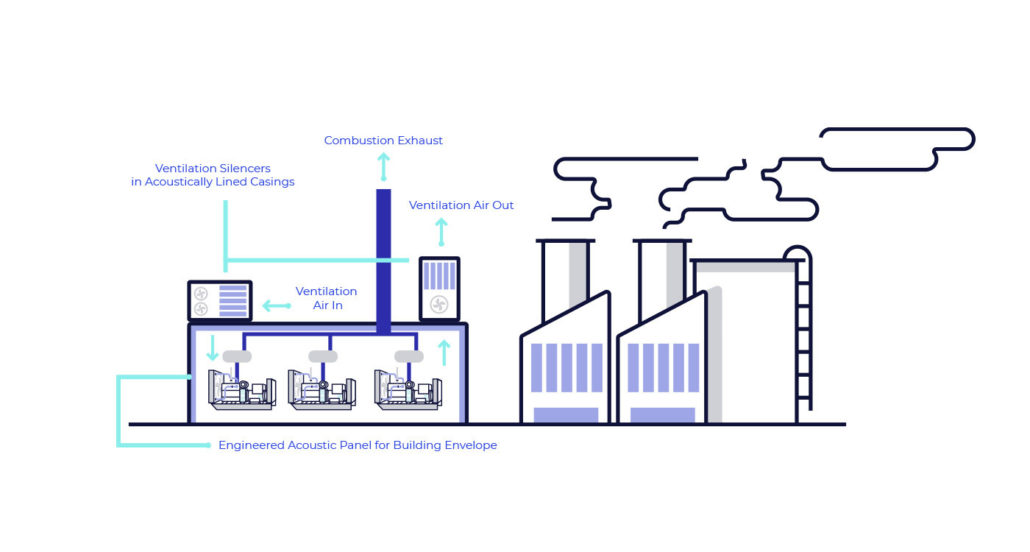 The entire building envelope can be designed to achieve the necessary transmission loss values through simple conventional building materials, or the integration of a modular acoustic panel system. The interior absorptive acoustic wall lining should form at least a portion of the interior space (typically 60 per cent coverage or greater) to reduce the reverberant noise levels and, subsequently, the mitigation requirements for the ventilation system. The ventilation system can be consolidated to a series of fans that move outside air through the building. These fans can be retrofit with custom design silencers wherever space is most practical. To facilitate a more practical installation, the silenced ventilation system can be designed as a prefabricated modular assembly.
The entire building envelope can be designed to achieve the necessary transmission loss values through simple conventional building materials, or the integration of a modular acoustic panel system. The interior absorptive acoustic wall lining should form at least a portion of the interior space (typically 60 per cent coverage or greater) to reduce the reverberant noise levels and, subsequently, the mitigation requirements for the ventilation system. The ventilation system can be consolidated to a series of fans that move outside air through the building. These fans can be retrofit with custom design silencers wherever space is most practical. To facilitate a more practical installation, the silenced ventilation system can be designed as a prefabricated modular assembly.
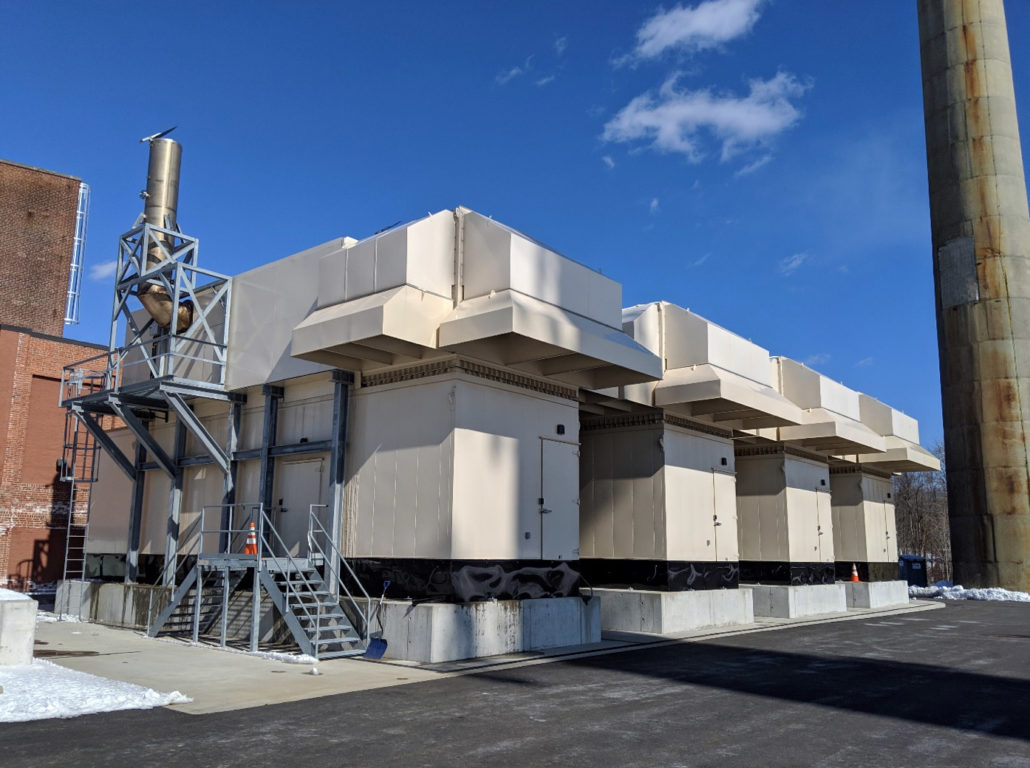
- Basement Mechanical Space: Where space permits, installing a CHP plant in a basement mechanical space is generally ideal from a noise control perspective, because the below grade foundation walls provide excellent transmission-loss capabilities.
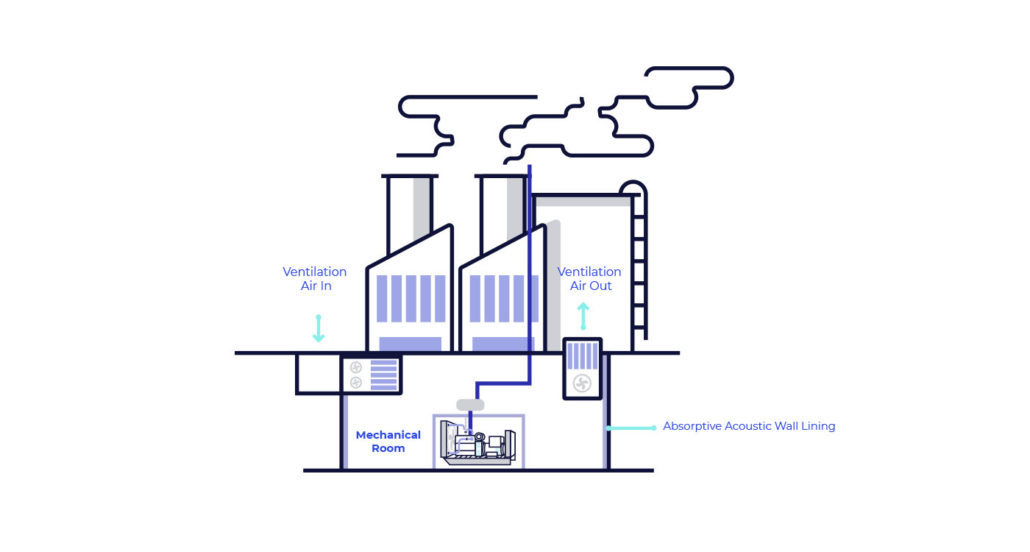
In these scenarios, ventilation noise would be generally controlled through the same means as in the dedicated building scenario. A major consideration is therefore controlling reverberant noise in the space in addition to sound transfer across adjacent occupied spaces. This could be achieved through a combination of at-source acoustic enclosures (as described in scenario 1) and an absorptive acoustic wall lining retrofit to the inside of the foundation walls. An example of this scenario can be seen in another recent Parklane case study).
In either of these scenarios, the integration of noise control will generally impact virtually every critical element of CHP design: ventilation, space, mechanical function, structural capacity, etc. Thus, CHP noise control design requires close collaboration with all project stakeholders to ensure the project is not exposed to any unforeseen or unnecessary cost and scheduling risks.
Expect CHP sound challenges
For facility owners and their design teams, the best strategy at the onset of any CHP project is to assume that sound emissions will be a challenge. This will influence appropriate forethought and discussion around sound emissions before the design progresses too far. By working with an experienced engineering firm that specializes in noise control—along with qualified acoustical consultants and other key project stakeholders—they can access the necessary depth of expertise and the right lay-in design support service for a better overall outcome.
Having agile suppliers at the ready also helps speed project rollouts when timelines are tight, allows for better coordination of various trades and ensures full regulatory compliance upon completion of the project.
The right team, in other words, is critical to attenuating CHP noise issues—whether proactively in the design phase, or reactively when those issues put a facility’s continued operation at risk.
The Parklane team
For assistance with your CHP noise control challenges, contact a member of our team.
